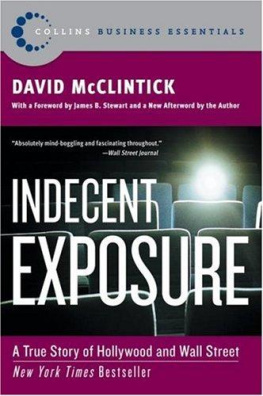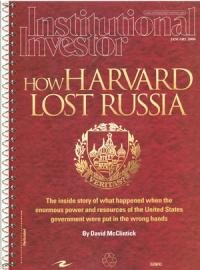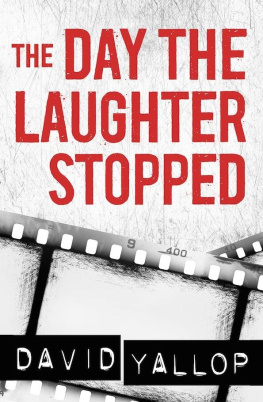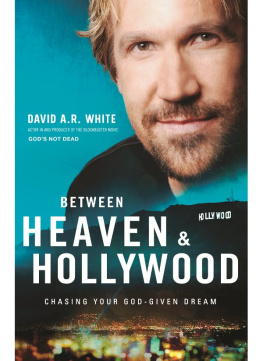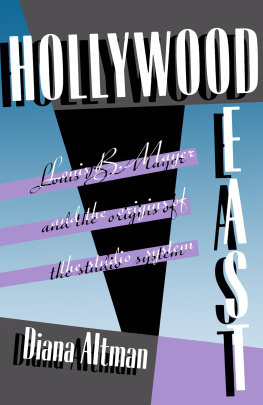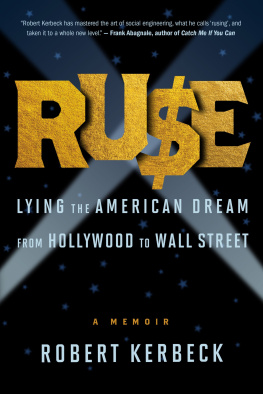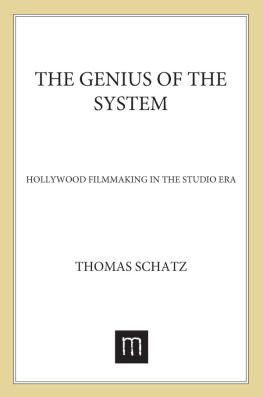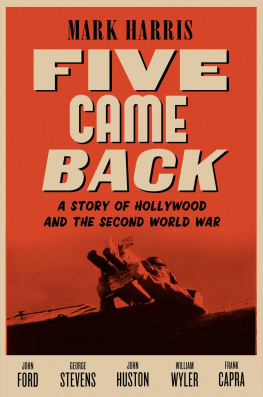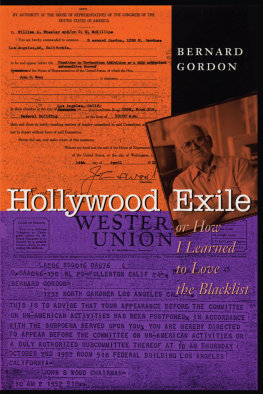Indecent Exposure
A True Story of Hollywood and Wall Street
David McClintick
INDECENT EXPOSURE
A CORGI BOOK 0 552 12389 7
Originally published in Great Britain by Columbus Books
PRINTING HISTORY
Columbus edition published 1983 Corgi edition published 1984 Corgi edition reprinted 1984
Copyright 1982 by David McClintick
Conditions of sale
1.This book is sold subject to the condition
that it shall not, by way of trade or otherwise,
be lent, re-sold, hired out or otherwise circulated
without the publisher's prior consent
in any form of binding or cover
other (ban that in which it is published
and without a similar condition including this condition
being imposed on the subsequent purchaser.
2.This book is sold subject to the Standard Conditions
of Sale of Net Books and may not be re-sold in the UK
below the net price fixed by the publishers for the book.
Corgi Books are published by Transworld Publishers Ltd., Century House, 61-63 Uxbridgc Road, Ealing, London W5 5SA
Made and printed in Great Britain by
Hunt Barnard Priming Ltd., Aylesbury, Bucks.
For Judy and
For my parents Dorothy and Dean McClintick
ACKNOWLEDGMENTS
I am grateful to a large number of people whose aid and comfort were crucial in the writing of this book friends and acquaintances in the entertainment industry and the business world at large, as well as at my former professional home, The Wall Street Journal. They contributed time, encouragement, and various forms of more tangible helpsometimes when it was not convenient, and occasionally against their better judgment. Most of them would be uncomfortable if I named them, but they know who they are and how much they mean to me.
In the category of equally important people who can be identified, I should like to thank the management and staff of William Morrow & Company, especially my outstanding editor, James Landis, and of Dell Publishing Company, particularly Carole Baron and Susan Moldow.
Thanks also to Robert D. Sack, the finest libel lawyer in America and, not insignificantly, an astute editorial critic.
I owe the profoundest of gratitude to Kathy Robbins and Richard Covey, who have combined literary representation of the very highest quality with a deep and durable friendship that 1 cherish. They have, quite literally, changed my life. ' Finally, Judith Ludlam McClintick, my wife. The period of this book's preparation, and the writing itself, have encompassed times of pain and anguish. Judy has seen me through all of them with strength, grace, wit, and love.
AUTHORS NOTE
Everything in this book is realevery episode, scene, weather reference, conversation, and name. The reader is urged to consult the source notes for a detailed explanation of the author's modus operandi and a delineation of his sources.
\
"It's the jungle. It appeals to my nature.... It's more than a place where streets are named after Sam Goldwyn and buildings after Bing Crosby. There's more to it than pink Cadillacs with leopard-skin seat covers. It's the jungle, and it harbors an industry that's one of the biggest in the country. A closed-in, tight, frantically inbred, and frantically competitive jungle. And the rulers of the jungle are predatory and fascinating and tough. L. B. Mayer is one of the rulers of the jungle. I like L.B. He's a ruler now, but he has to watch his step or he'll be done in. He's shrewd. He's big business.... L.B. is tough. He's never trying to win the point you're talking about. His aim is always long-rangeto keep control of the studio. He loves Dorc. But someday he'll destroy Dore. L.B. is sixty-five. And he's pink. And healthy. And smiling. Dore is about twenty years younger. And he looks old. And sick. And worried. Because L.B. guards the jungle like a lion. But the very top rulers of the jungle are here in New York. Nick Schenck, the president of Loew's Inc., the ruler of the rulers, stays here in New York and smiles, watching from afar, from behind the scenes, but he's the real power, watching the pack close in on one or another of the lesser rulersclose in, ready to pounce! Nick Schenck never gets his picture in the papers, and he doesn't go to parties, and he avoids going out in public, but he's the real king of the pack. And he docs it all from New York! God, are they tough!"
John Huston 1950
"The new Hollywood is very much like the old Hollywood."
David Chasman
Executive Vice President, MGM
ONE
Evelyn Christel, a slim woman of forty-one with short blond hair, cased her brown Pinto from Van Nuys Boulevard into the rush-hour crawl of the Ventura Freeway and headed cast. She squinted into the sun, which had just cleared the snow-covered San Gabriel Mountains on the far horizon straight ahead.
It was 8 A.M., Friday, February 25, 1977, clear and bracingone of the chilliest mornings of the brief, subtropical Los Angeles winter.
Evelyn's drive would take thirty-five minutes if she was lucky, forty-five minutes if she was not. Like thousands of logs glutting a river, the traffic crept past Bullock's and I. Magnin, Coldwater Canyon Avenue and Laurel Canyon Boulevard. Twenty miles an hour, then fifty, then ten.
Evelyn negotiated a careful merge with the southeast-bound Hollywood Freeway. Universal Studios on the left. Cahuenga Pass through the scrubby hills, green from the winter rains. Hollywood Bowl on the right.
Off the freeway at Vine. South on Vine down the hill, stop-and-go, through Central Hollywood. The Capitol Records Tower. TAV Celebrity Theater Presents the Merv Griffin Show. Art City.
Vine becomes Rossmore at Melrose. Along Rossmore. gently curving, past the Wilshire Country Club and the grand old homes of Hancock Park, all the way to Wilshire Boulevard. A long light, then across Wilshire to the stone gates of Fremont Place, an elegant and very private residential enclave. Another wait while the guard located Evelyn's name on his list. Over the speed bump, around the corner to the right, and into the driveway of the first house. 97 Fremont Place West, where Evelyn's employer. Cliff Robertson, the motion-picture actor, was in temporary residence.
Evelyn might have preferred a commute as short as those during Cliffs previous extended visits to Los Angeles. He had rented houses in Coldwatcr Canyon and Brentwood, which were much closer to her home in the working-class San Fernando Valley community of Van Nuys. But in nineteen years as Cliff Robertson's part-time secretary, Evelyn Christel had grown used to, and actually quite fond of, just about all of Cliffs eccentricities, mainly because they weren't really eccentricities at all but quite normal traits that seemed eccentric only in Hollywood. One of them was a strong preference for living near where he was working. Most movie celebrities, no matter how remote the location of the studio that might be employing them at a particular time, insisted on living in Beverly Hills or Bel-Air. Any other place would have threatened their self-image. Cliff Robertson, however, wasn't so insecure as most in Hollywood (another of his "eccentricities"). Although he sought out luxurious comfort wherever he went, it didn't necessarily have to have a chichi name like Beverly Hills. And since he was making a movie at Paramount that winter, the real-estate agent had suggested to Evelyn Christel that Cliff consider Fremont Place, which was only five minutes from the Paramount lot.
Most of the seventy-three houses in the half-century-old enclave were as elegant as many in Beverly Hills. But only three celebrities lived in Fremont PlaceMuhammad Ali, the heavyweight boxer; Karen Black, the film actress; and Lou Rawls, the pop singer. The majority of the residents were lawyers, bankers, and businessmen who drove cast to offices in the skyscrapers of downtown Los Angeles instead of west and north to the show-business factories of Beverly Hills, Hollywood, and Burbank. Fremont Placers tended mildly to disdain the entertainment industry; its products occasionally were amusing, but its people and ambience were too gaudy and often too vulgar for the modest and somewhat smug sensibilities of Fremont Place.

